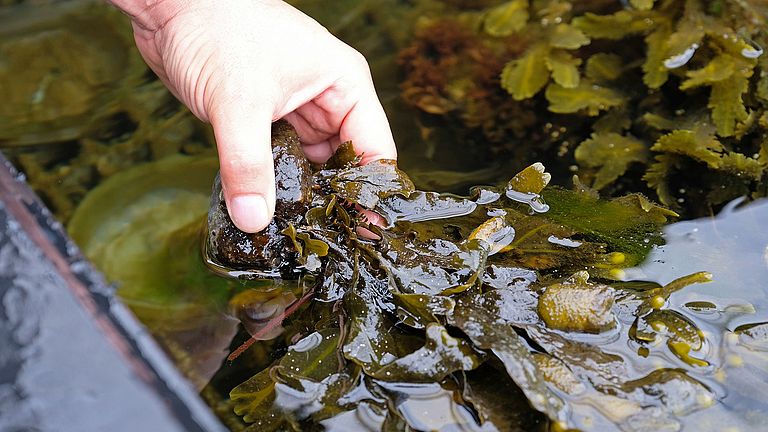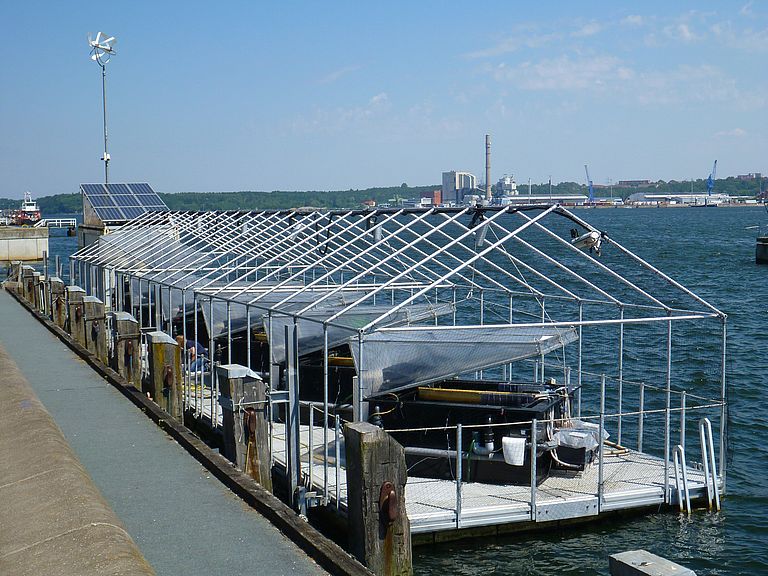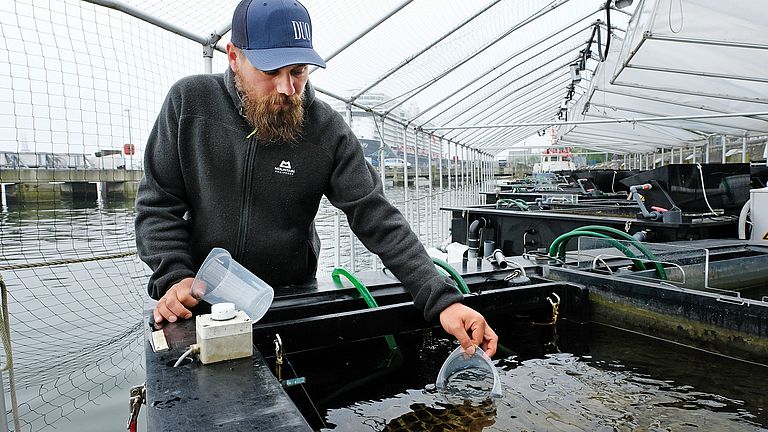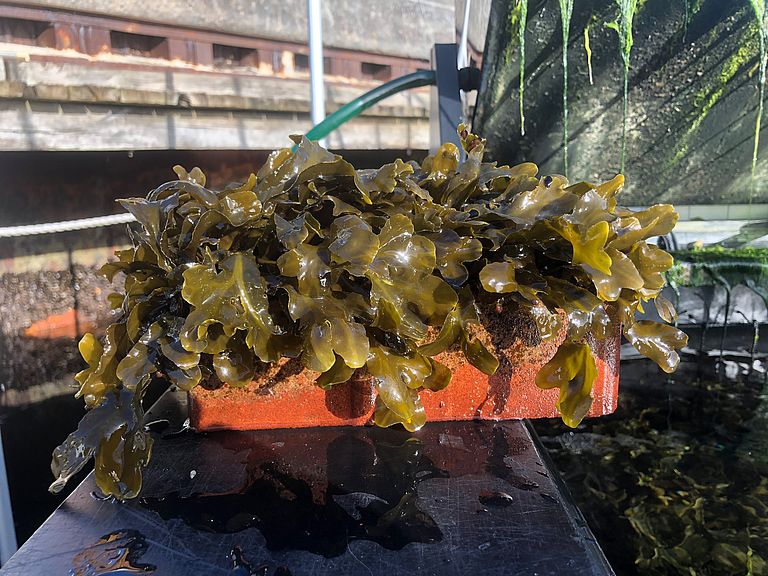Towards a better water quality in the Baltic Sea
New research project tests cultivation of algae on foundations of wind power plants
“Even if you do not always see it everywhere, the Baltic Sea is in a bad condition,” says marine ecologist Professor Dr. Ulf Karsten from the Institute of Biosciences at the University of Rostock. “This is mainly due to the still excessive inflow of nutrients, which massively alter the water quality. However, bladderwrack and other algae are able to filter nutrients from the Baltic Sea.” Together with Rostock researchers Dr. Jörg Burgstaler and Dr. Denny Wiedow, biogas specialists at the Faculty of Agricultural and Environmental Sciences at the University of Rostock, he coordinates the project “Climate-friendly offshore production of algae biomass”, which is funded by the German Federal Environmental Foundation (Deutsche Bundesstiftung Umwelt, DBU). For the kick-off, the participants met at GEOMAR Helmholtz Centre for Ocean Research Kiel, another project partner.
The project builds on the DBU pilot project “Living Lab Eckernförder Bucht 2030”. In this project, coordinated by Kiel University, essential preliminary work was done and a first catalogue of measures developed. The goal of the new research project now is to determine which measures can improve the water quality of the over-fertilised Baltic Sea. In addition, the algae are high-quality biomass. For example, the idea has already been developed to extract valuable substances for the cosmetics industry from the seaweed. Centrepiece of the new project is a pilot plant in the Eckernförde Bay. With its help, the researchers will investigate whether cultures of macroalgae – mostly the bladderwrack Fucus vesiculosus, frequently found on Baltic Sea beaches – grows on the foundations of wind power plants. To this end, the project group will develop raft structures in the Eckernförde Bay that resemble the foundations of wind power plants. The bladderwrack will then be grown on these. The cultures are to help reduce the nutrient content in the Baltic Sea. “Brown algae like bladderwrack need nutrients to grow. And there are more than enough nutrients in the Eckernförde Bay. A whole forest of these marine plants could therefore do the bay a lot of good by absorbing plenty of nutrients and thus improving the water quality,” explains Professor Karsten. However, the seaweed must be retrieved in time before it decomposes. This has already worked very well in laboratory tests.
Seagrass meadows would also benefit from improved water quality. These play a central role in the Baltic Sea ecosystem. They offer small animals and fish both protection and food, store large amounts of carbon dioxide, release oxygen into the water and solidify the sediments on the seabed.
Since 2013, researchers at GEOMAR Helmholtz Centre for Ocean Research Kiel have been investigating how bladderwrack and organisms in the Baltic Sea react to the effects of climate change and other human influences. “Building on our expertise, we can optimise the cultivation of bladderwrack and also take into account possible future changes in its ecosystem,” explains Professor Dr. Martin Wahl, marine biologist at GEOMAR. “This is important if we want to ensure long-term usability.”
In order to answer the pressing questions about the feasibility of year-round project work and the sustainability of macroalgae farming in the Baltic Sea, extensive analyses in all research disciplines are necessary. After all, algae aquaculture could not only be a sustainable source of income, but also a tool for sequestering carbon, recovering nutrients from over-fertilised coastal waters and maintaining and restoring biodiversity and ecosystem services in disturbed environments.
Professor Katrin Rehdanz from the Institute of Economics at Kiel University, for example, will contribute a socio-economic evaluation. “In addition to the economic benefits for individual industries that could profit from algae aquaculture in the future, macroalgae farming also contributes ecologically to a better climate balance. But potential conflicts of use and costs must also be taken into account. We are looking at these aspects in the project,” says Kiel-based environmental and energy economist Rehdanz.
“The project in the Eckernförde Bay is intended in particular to close research gaps in the field of marine nature and environmental protection in the Baltic Sea,” says Professor Ulf Karsten from the University of Rostock, looking ahead. In this way, it contributes to achieving the German environmental goals according to the Marine Strategy Framework Directive of the European Union. Using the Eckernförde Bay as an example, ecological relationships are to be investigated and the protection of marine habitats further developed.
According to Professor Karsten, a successful project could also be profitable for agriculture. For his vision is to use the remains of the biomass as a fertiliser substitute in agriculture. “This would stimulate humus formation in the soil and increase soil fertility.” To this end, the Rostock researchers will examine the quality of the biomass and, in particular, check how high the proportions of sugar, fats and proteins are. The aim is to make the Eckernförde Bay a model for other regions in the Baltic Sea region, he said.

Bladderwrack in an experimental chamber of the Kiel Outdoor Benthocosms. Photo: Jan Steffen/GEOMAR

The Kiel Outdoor Benthocosms (KOBs) at GEOMAR are a unique experimental facility for simulating environmental conditions as they are to be expected in the future. The KOBs are particularly suitable for bottom-dwelling organisms of the Baltic Sea, such as the bladderwrack. Photo: Angelika Graiff/University of Rostock.

Investigation of water quality in an experimental chamber of the Kiel Outdoor Benthocosms. Photo: Jan Steffen, GEOMAR

Successful cultivation of bladderwrack on a brick in a GEOMAR field test facility. Photo: Martin Wahl / GEOMAR


